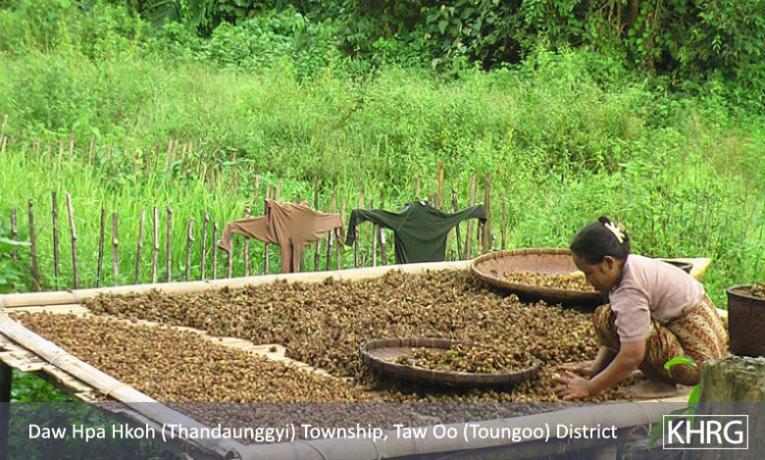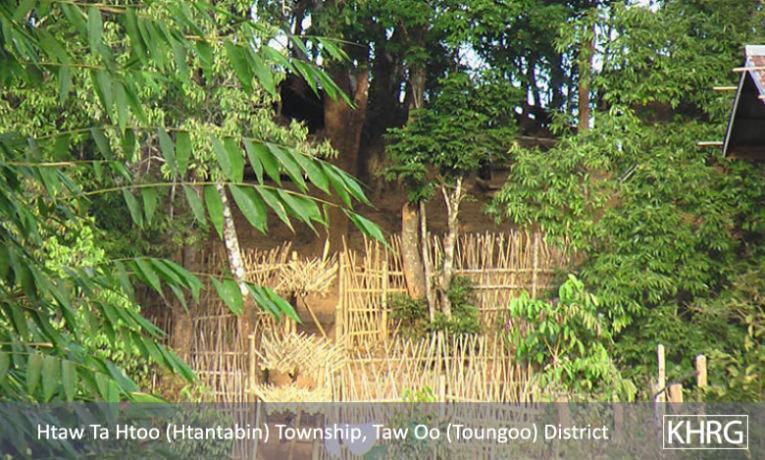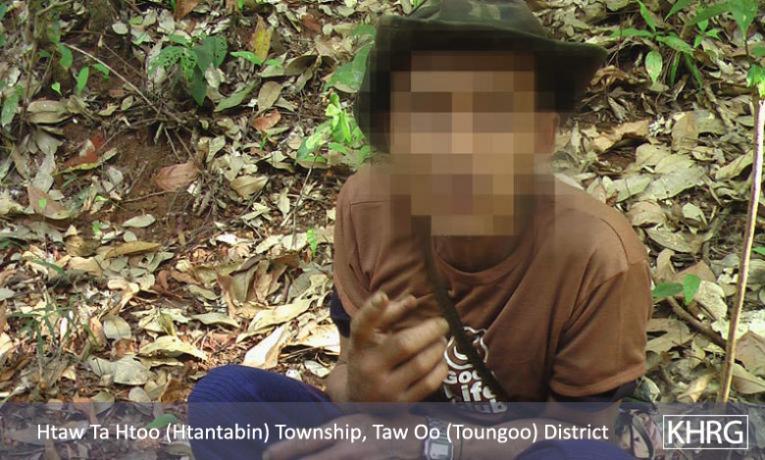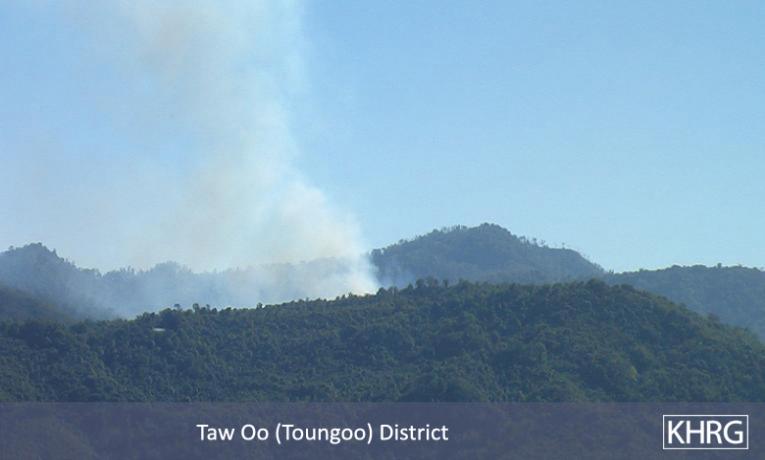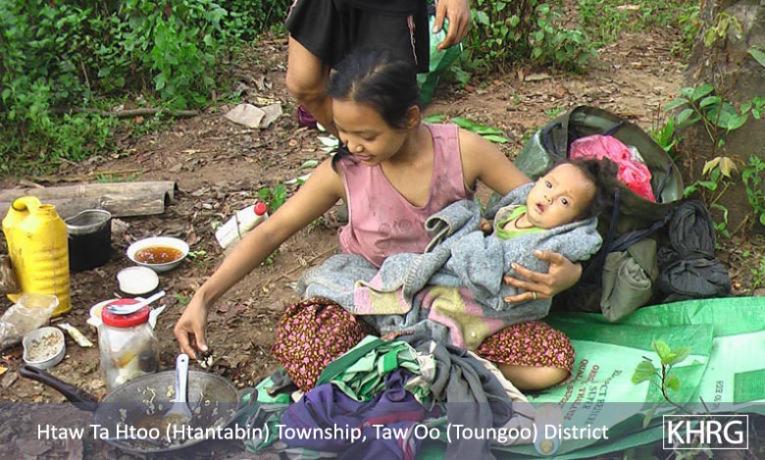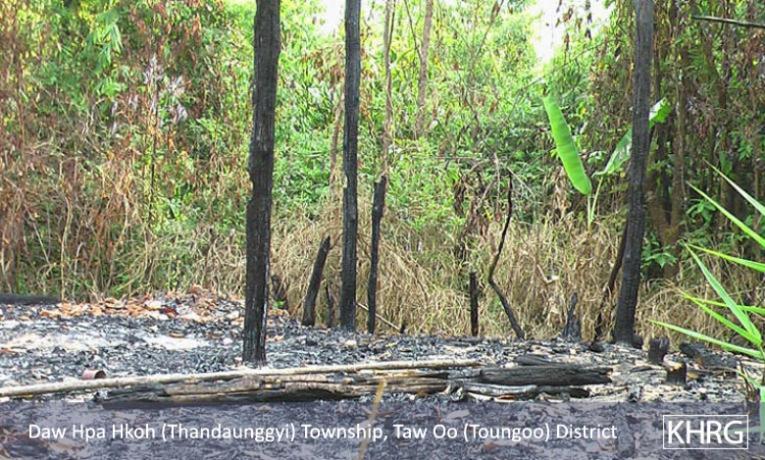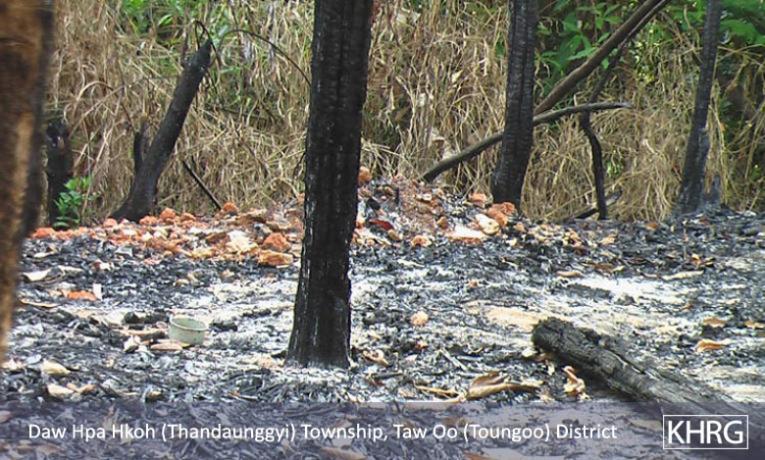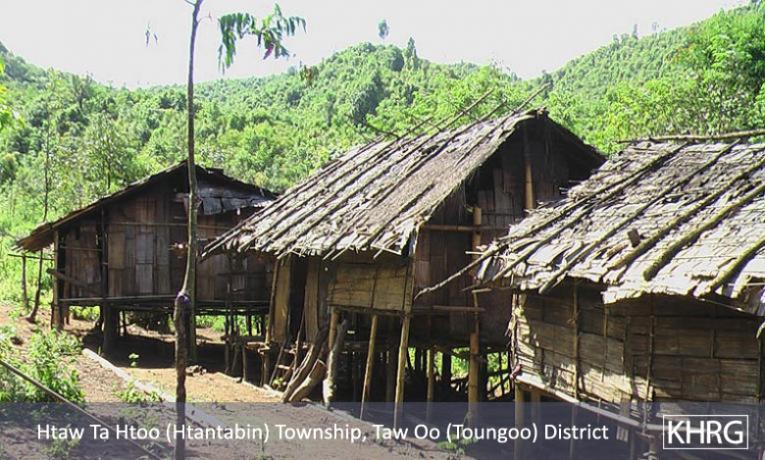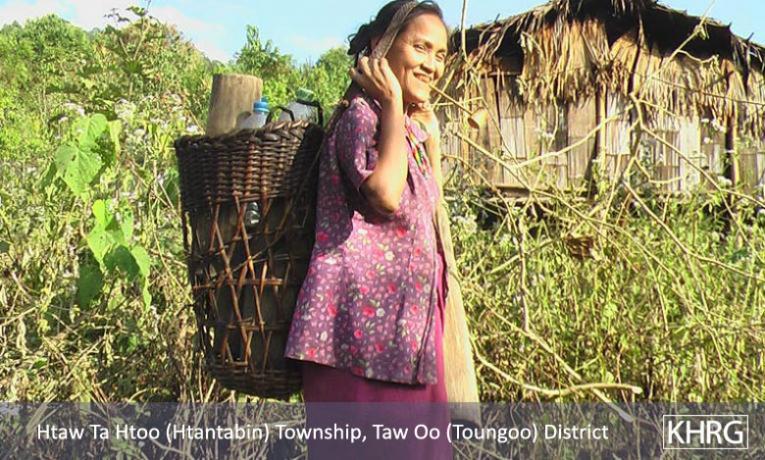This field report documents recent human rights abuses committed by SPDC soldiers against Karen villagers in Toungoo District. Villagers in SPDC-controlled areas continue to face heavy forced labour demands that severely constrain their livelihoods; some have had their livelihoods directly targeted in the form of attacks on their cardamom fields. In certain cases individuals have also been subjected to arbitrary detention and physical abuse by SPDC soldiers, typically on suspicion of having had contact with the KNU/KNLA after being caught in violation of stringent movement restrictions. Villagers living in or travelling to areas beyond SPDC control, meanwhile, continue to have their physical security threatened by SPDC patrols that practice a shoot-on-sight policy in such areas. This report covers incidents between January and April 2010.
On December 26th 2009, State Peace and Development Council (SPDC) troops from Military Operation Command[1] (MOC) #5 were rotated out of Toungoo District after two years of operations,[2] and replaced by units from MOC #7.[3] MOC #7 consists of ten battalions: Light Infantry Battalions (LIBs) #336, 421, 423, 424, 425, 426, and 427; and Infantry Battalions (IBs) #102, 250, and 261. According to KHRG’s field researchers, since their deployment seven of the ten battalions of MOC #7 have been active conducting patrols or other operations in the hills of southern Toungoo at any given time, while three battalions have been stationed at larger more central bases along the main roads, with battalions rotated between the front lines and main camps as often as twice a month. Soldiers from Karen National Liberation Army (KNLA) 2nd Brigade also continue to be active in Toungoo District, including laying landmines and launching attacks on SPDC operations.
Sustained military activity by MOC #7 combined with the broader militarization of Toungoo District heavily impacts civilian lives and livelihoods. Villagers living under full or partial SPDC control face frequent demands for forced labour, especially as porters in support of troop rotations, re-supply and deployment. The manner in which military authorities attempt to control the civilian population also leaves villagers exposed to violent abuses; individuals caught in violation of movement restrictions may be heavily fined or even shot, while anyone suspected of having any contact with the KNLA faces destruction of their property, arbitrary arrest, detention, and ill-treatment. Villagers inhabiting or travelling to areas beyond SPDC control, meanwhile, risk being shot on sight if spotted by an SPDC patrol.
Such circumstances severely constrain the livelihoods activities of villagers across Toungoo District by limiting the amount of time they can spend planting, tending, and harvesting their crops, undermining access to markets and, in some cases, exposing them to potential physical harm when they engage in everyday livelihoods activities. Since the soil quality and terrain in much of Toungoo support only limited rice or paddy farming, the majority of the population survives on income generated from various plantation crops, such as betelnut, betel leaf, [4] cardamom, durian and dog fruit. Villagers work year-round raising different crops depending on the season, and must transport and sell or trade their harvest in towns in order to acquire essential food items such as rice.
From January until the end of May, for example, is the period for harvesting and selling betel leaf. The price of betel leaf changes each month depending on supply; in March the price rises from 3,000 kyat (US $3.06) to as much as 5,000 kyat (US $5.10) per viss (1.6 kg. / 3.6 lb.). For those villagers keeping durian plantations, the durian trees flower in March and the fruit can be harvested and sold in May and June. At the beginning of June when the rainy season starts, villagers shift their attention to their cardamom plantations; weeds must be cleared, and plantations maintained regularly throughout the rains. Cardamom is then harvested in August and September as the rainy season comes to an end, and can be sold for 10,000 – 12,000 kyat (US $10.20 - $12.24) per viss during this period. August and September are also the months for picking and selling dogfruit, which usually flowers in February. October to December is the main season for harvesting and selling betelnut, which fetches 4,000 – 5,000 kyat (US $ 4.08 - $5.10) per viss.[5] In addition to these peak times for cultivating and harvesting each crop, villagers have to undertake regular maintenance activities on plantations outside the main cultivation periods; time and labour must be devoted year-round to burning, planting, pruning, weeding, and other maintenance activities such as protecting the crops from wild animals. Some of these products, particularly fruits from orchard trees like durian and dog fruit, also require considerable investments of labour over multiple years before they produce harvestable goods, as the trees must be nurtured until they mature to a certain age before they bear quantities of fruit.
Rural livelihoods in Toungoo thus require carefully planned, daily labour of villagers, regardless of whether they live under SPDC control or in non-state controlled areas. Time demanded by SPDC authorities for involuntary labour, movement restrictions that obstruct trade and commerce and may threaten the physical security of civilians, and attacks on villagers’ homes and plantations, all greatly limit villagers’ capacity to pursue these livelihoods, with direct consequences for their own and their families’ health and food security. As the following sections will show, the high activity of the SPDC battalions under MOC #7 currently deployed to Toungoo has created circumstances in which the above-mentioned abuses occur regularly, heavily proscribing the space for villagers to engage in crucial livelihoods activities.
Forced portering and forced labour
SPDC units active in Toungoo District typically start to send rations to re-supply their bases along the main roads in October and November, when the rainy season ends; this can continue until December or January, depending on the state of the roads.[6] Supplies are transported by truck from the SPDC Southern Regional Command[7] headquarters in Toungoo town to the larger bases along the Toungoo to Kler La to Mawchi road, and the Kler La to Buh Hsa Kee road, including Bpeh Leh Wah, Kler La, Gklay Soh Kee, Th’ay Hta, Gkaw Thay Der, Naw Soh, and Buh Hsa Kee. This delivery is carried out using a limited number of army trucks and by commandeering civilians’ trucks and motorcycles.[8] The second stage of the re-supply operation entails transporting rations from depots at the bases along the main roads to more remote camps nearer the front lines. This takes place between January and March and is largely completed through the use of forced porters demanded from villages located near army camps or, as previously documented by KHRG, the use of convict porters imported from prisons around Burma.[9]
On January 2nd 2010, for example SPDC soldiers from LIB #421 under the command on Win Bo Shain based at the SPDC camp in Klaw Mi Der, Tantabin Township, demanded thirty villagers to retrieve LIB #421’s rations from the SPDC base at Bpeh Leh Wah on the Toungoo to Kler La road. Ten women and 20 men from Klaw Mi Der had to make the one-hour journey on foot to Bpeh Leh Wah and back to Klaw Mi Der: time they could not spend working to provide for their families, and for which they were not compensated. On February 9th 2010, LIB #421 again forced 30 Klaw Mi Der villagers, all male, to porter rations. This time, the villagers had to carry supplies southwest from the army camp at Klaw Mi Der to another camp at Ler Kla Der, a three-hour journey each way.
On January 12th 2010, LIB #427, under Commander Tin Maung Cho, ordered villagers to porter rations from their base at Gkaw Thay Der, Tantabin Township along the Kler La to Buh Hsa Kee road to the camp at Th’ay Hta, on the Kler La to Mawchi road (see photo above). Porters were demanded from Gkaw Thay Der, Gklay Soh Kee, Ber Koh, Der Doh, Maw Koh Der, Gkleh Gaw Der, and Kler La, all of which are located in Tantabin Township. The walk from Gkaw Thay Der to Th’Ay Hta takes four hours each way. KHRG has previously reported serious concerns about landmines in this area, along both the Kler La to Buh Hsa Kee and the Kler La to Mawchi roads; as recently as January 2nd 2010 a group of forced porters refused to travel ahead of a group of soldiers along the stretch of road between Kler La and Th’ay Hta because they feared stepping on landmines laid by the KNLA.[10]
On January 28th 2010, troops from LIB #264 led by Nyoh Leh under the command of the SPDC Southern Regional Command Headquarters in Toungoo forced nine villages in the vicinity of Ker Weh, Than Daung Township to carry rice and cooking oil to the camp at Par Der Ka. Par Der Ka is a three-hour hike to the east across the Day Loh River. Although KHRG’s researchers could not obtain details about the number of villagers forced to serve as porters, the amount of rations transported, 400 50-kilogram sacks of rice, suggests that quite a large number of villagers would have been required to serve as porters. The villages which were forced to transport the rations are listed in the table below, along with a description of what they were required to carry. Each “sack” of rice is of a standard measure and weighs 50 kilograms (110 lb.), while bottles of cooking oil are transferred from a larger container (a drum) to more portable vessels, and are therefore not of a fixed volume or weight.
|
# |
Village Name |
Description of Items |
Approximate Weight |
|
1 |
Ker Weh |
100 sacks of rice |
5,000 kg. / 11,023 lb. |
|
2 |
Gka Thaw Bpeh |
50 sacks of rice |
2,500 kg. / 5,551 lb. |
|
3 |
Thoo Gheh Der |
40 sacks of rice |
2000 kg. / 4409 lb. |
|
4 |
Htee T’Bpoo |
40 sacks of rice |
2000 kg. / 4409 lb. |
|
5 |
Khoo Thay Der |
40 sacks of rice |
2000 kg. / 4409 lb. |
|
6 |
Kaw Law Gkah |
30 sacks of rice |
2000 kg. / 4409 lb. |
|
7 |
S’Ba Law Kee |
30 sacks of rice |
2000 kg. / 4409 lb. |
|
8 |
Ler Ghee Koh Der Gkah |
30 sacks of rice |
1500 kg. / 3307 lb. |
|
10 bottles of cooking oil |
n/a |
||
|
9 |
Ler Ghee Khoh Der |
40 sacks of rice |
2000 kg. / 4409 lb. |
|
10 bottles of cooking oil |
n/a |
The current SPDC strategy of frequently rotating battalions in Toungoo results in new forced labour demands being made whenever units move in or out of a given area. The heavy forced labour requirements imposed on villagers living near military camps in the months after the rainy season may therefore persist through much of the year. Villagers are obliged to support military units through various forms of forced labour, including camp and road maintenance and construction; the preparation and delivery of materials for camp construction (eg. bamboo poles or thatch shingles); portering of rations and other supplies; serving as set tha,[11] sentries or guides for units; and by providing material support through arbitrary taxation such as food, money, and materials. All of these activities take away from villagers’ own finite time, energy and resources. The more frequently battalions are rotated, or the more battalions that are based in an area, the more time villagers may be required to spend away from their normal livelihoods activities, against their will and uncompensated. This reflects the SPDC’s requirement that its units “live off the land” by exploiting available resources in their area of deployment, including the civilian population, to satisfy basic logistical needs.[12] As militarization of Toungoo District has increased, so too have the frequency and prevalence of exploitative abuses experienced by villagers.
One of the ways in which SPDC units across Karen State have ensured that civilian populations are constantly available to be tapped for labour or resources is through the establishment of relocation sites near roadways and army camps, and large-scale forced relocations of villagers to these areas.[13] One such site is Play Hsa Loh in Tantabin Township, which was created as a relocation village for residents of Yer Loh, Plaw Baw Der, Lay Hoh Loh, Bpaw Pa, and (old) Play Hsa Loh.[14] Over 900 villagers from 160 households have been relocated to Play Hsa Loh since it was founded in 2006. KHRG has repeatedly documented the use of forced labour by SPDC units based in Play Hsa Loh.[15] According to KHRG’s researchers, on February 9th 2010, IB #261, which is based in Play Hsa Loh under Commander Yai Yin Naing, ordered the villagers cut and deliver bamboo poles to the camp. Each household in Play Hsa Loh was required to provide five 12-foot-long bamboo poles.
Arbitrary detention and killing
As discussed above, the presence of a large number of highly-active SPDC battalions across Toungoo District is directly enabled by the SPDC’s strong control and routine exploitative demands made of the civilian population, especially for forced labour. Exploitative abuses are a regular challenge that seriously undermines villagers’ livelihoods, but they are not the only abuses stemming from militarization reported to KHRG. Toungoo villagers also face grave threats to their physical security from strategic measures ostensibly employed as part of offensive SPDC operations against KNLA forces.
Recently the MOC #7 units based in Gkaw Thay Der and Naw Soh, along the Kler La to Buh Hsa Kee road in Tantabin Township, have been extremely active, operating and conducting patrols in the hills around their camps. SPDC units have waged a sustained campaign to depopulate villages in the hills of southern Toungoo. This has included regular patrols through the hills during which villagers are detained or shot on sight and fields under cultivation are destroyed; the shelling of villages beyond SPDC control; as well as the enforcement of strict movement and trade restrictions across Toungoo District in order to prevent food supplies and other support from reaching villagers who remain in hiding in the hills near their home villages.[16]
HRG’s field researchers report that LIB #427, the unit currently based in Gkaw Thay Der under the command of Tin Maung Cho, has been running ongoing operations in the surrounding area; whenever troops see any villagers outside of the village, they arrest them for or suspect them of having had contact with the KNU/KNLA. Previous KHRG reports have detailed the stifling movement restrictions placed on villages under tight SPDC control, such as in Gkaw Thay Der village, and their negative consequences for civilian livelihoods;[17] as a result, Toungoo villagers frequently find themselves in situations where they must incur serious risks to their physical security to covertly violate movement restrictions to engage in basic livelihoods activities. On April 2nd 2010, when LIB #427 was on patrol outside Gkaw Thay Der village, they encountered and detained Saw May Neh (aka Taw Thoo), a local villager who had gone into the forest to collect firewood. According to his aunt, Naw Taw Kaw, who spoke with a KHRG field researcher, Saw May Neh was arrested because the LIB #427 soldiers saw that he was missing his left eye and accused him of having sustained the injury while serving in the KNLA. Naw Taw Kaw, however, asserted that her nephew had never been a soldier and had lost his eye in a landmine explosion in August or September 2007. The accident occurred while Saw May Neh, along with 100 other villagers from Gkaw Thay Der, were serving as forced porters transporting rations for the SPDC Army.[18] The troops forced the villagers to walk ahead of them, a practice employed by SPDC forces in areas where they suspect landmines may have been planted.[19] One of other the porters stepped on a landmine as the group arrived in May Daw Koh village, and the blast permanently wounded Saw May Neh’s left eye.
In a separate incident on April 7th 2010 another Gkaw Thay Der villager, Saw Ta Oo Oo, was detained by soldiers from LIB #425 at a checkpoint on the Toungoo to Kler La road at the Bpeh Leh Wah SPDC camp.[20] Saw Ta Oo Oo was taking his grandson to attend a summer course in Toungoo Town in neighbouring Pegu Division (see map); the program is held in Toungoo each year while schools are closed for summer; children typically study the Karen language, music (guitar), and the Bible. Saw Ta Oo Oo hired a motorcycle driver to take him and his grandson together to Toungoo; however, when they arrived in Bpeh Leh Wah, a two-hour drive from Gkaw Thay Der, the soldiers detained him and ordered the motorbike rider to return with Saw Ta Oo Oo’s grandson to Gkaw Thay Der. The reason for his arrest was not clear. Villagers in Bpeh Leh Wah reported that the troops who arrested Saw Ta Oo Oo then tortured him by holding his head under water; they also took 40,000 kyat (US $41) that he had been carrying with him.
The whereabouts of both Saw May Neh and Saw Ta Oo Oo after their respective arrests were not disclosed by SPDC authorities. Local villagers were not sure whether the men had been killed, sent to MOC #7 headquarters in Kler La, to the camp at Gkaw Thay Der, or to the Regional Command Headquarters in Toungoo Town, all of which were possible based on locals’ experience with previous cases of arbitrary arrest and detention in Toungoo. The village headman of Gkaw Thay Der requested to meet with the men and provide his guarantee of their identity, as he believed the men had no connection with the KNLA and had been detained without cause, but his overtures were rejected by SPDC authorities and the men continued to be held incommunicado. On May 3rd 2010 the Karen-language news agency Kwekalu reported that both men had been killed in detention by LIB #426 on April 7th and April 19th 2010: according to the report, Saw Ta Oo was killed at Bpeh Leh Wah, and Saw Meh New (aka Taw Thoo) at Kler La.[21]
Attacks on cardamom plantations
Many villagers in Toungoo District raise cardamom because the terrain and quality of the soil in much of the region does not support rice production. Cardamom is a resilient cash crop that can be grown in nutrient-poor soil in small plots and even in hilly terrain; it is durable enough to be carried to markets to trade for rice and other essential items.[22] Toungoo villagers believe that SPDC forces have targeted their cardamom plantations because of the perceived link between income earned from cardamom and support for the KNLA. In 2006 an SPDC radio message supposedly instructed units deployed to Toungoo District to step up the destruction of
ardamom crops as well as other fruit plantations that might serve as a source of finances for the KNLA, and thereby force the group to negotiate with the SPDC; a similar order was reportedly issued in early 2008 by the SPDC Southern Command Headquarters in Toungoo Town.[23] If a plan to eradicate cardamom does indeed exist, it has not been made official or clearly explained to locals; when attacks are carried out on their plantations, villagers are therefore unprepared to secure their livelihoods in alternative ways. The burning of a cardamom plantation results in the loss of that year’s crop, which can be particularly devastating for villagers who have few or no other sources of income. Villagers however may be reluctant to abandon a plantation altogether regardless of how often it is attacked, since starting a new operation requires money and resources to which rural villagers may not have access, and new fields typically take three years of cultivation before they become profitable for farmers. Even villagers living under effective SPDC control along the major roads of Toungoo District have not been secure from such attacks on their livelihoods.[24]
In the most recent case reported to KHRG, on April 3rd 2010, troops from SPDC LIB #421 and IB #250 attacked and burned several cardamom plantations in the Day Baw Duh area of Tantabin Township when the units were rotating and conducting a joint operation. The plantations belonged to villagers from Gk--- village; the table below details the estimated losses incurred by five of these villagers, based on their expected harvests and an average price of 10,000 to 12,000 kyat (US $10.20 to $12.24) per viss (1.6 kg. / 3.6 lb.) of harvested cardamom.
|
# |
Name |
Amount of Cardamom lost |
Estimated Value |
|
1 |
Saw Me--- |
200 viss (326 kg. / 700 lb.) |
2,000,000 – 2,400,000 kyat (US $2,062 - $2,474) |
|
2 |
Saw Ma--- |
100 viss (163 kg. 350 lb.) |
1,000,000 – 1,200,000 kyat (US $1,031 - $1,237) |
|
3 |
Saw G--- |
100 viss (163 kg. / 350 lb.) |
1,000,000 – 1,200,000 kyat (US $1,031 - $1,237) |
|
4 |
Naw My--- |
50 viss (82 kg. / 175 lb.) |
500,000 – 600,000 kyat (US $516 - $618) |
|
5 |
Saw R--- |
70 viss (114 kg. / 245 lb.) |
700,000 – 840,00 kyat (US $722 - $866) |
|
Total |
520 viss (848 kg. / 1820 lb.) |
5,200,000 – 6,240,000 kyat (US $5,362 - $6,432) |
|
Day Baw Duh is located one and a half hour’s walk from Kler La; both Day Baw Duh and Gk--- village are under SPDC control. Villagers have reported to KHRG that SPDC troops responsible for burning their cardamom fields have told them they need to clear the land in order to be able to spot KNLA soldiers if and when the KNLA becomes active in the area in question.[25]
Attacks in non-SPDC-controlled areas
HRG continues to receive reports of attacks by the SPDC on villagers detected in areas outside of regular military control. As noted above, villagers inhabiting areas with a strong SPDC presence often find themselves compelled to disobey tight restrictions on their movement imposed by local authorities in order to carry out basic and necessary livelihoods activities. Villagers who have been forced into relocation sites by SPDC military operations similarly find their livelihoods constrained by movement restrictions, exploitative abuse, and a lack of land and food;[26] many covertly visit their old villages to maintain their fields and retrieve resources, in spite of the physical risks involved in doing so.[27]
On April 4th 2010, a group of villagers travelled from the relocation sites at S--- and T--- in Than Daung Township to K--- village in Tantabin Township, which they abandoned after being ordered to relocate by SPDC soldiers in 2006. The villagers told KHRG’s field researcher that they were attempting to return to K--- because there isn’t enough land to secure their livelihoods in their relocation villages, and they had hoped to be able to work their old fields covertly. As the group approached K---, a column of SPDC soldiers operating in the area, probably from LIB #421,[28] spotted them and immediately opened fire on them. The returning villagers escaped and waited until the next day, April 5th, when they once more tried to enter K---. Again, they were seen by SPDC troops on patrol and fired upon. The group escaped without injury but the villagers were ultimately prevented from returning to their former village, and the livelihoods difficulties they face in the relocation sites remain unresolved.
Villagers who have been able to avoid relocation and live and pursue their livelihoods beyond SPDC control must confront such threats to their physical security on a far more regular basis. These communities may utilise flight as a strategy to protect themselves from attacks and other forms of human rights abuse associated with military operations, while continuing to resist SPDC control.[29] Villagers from Th’Ay Kee in Tantabin Township, for example, have in the past faced SPDC attacks, including having their homes and food stores burned, and have shifted their residence to hiding sites in the jungle around the village during periods when SPDC soldiers are active in their area.[30] Th’ay Kee and the surrounding hiding sites are located less than one hour’s walk from the Kler La to Buh Hsa Kee vehicle road, and are targeted by patrols when SPDC forces send rations from Toungoo Town to major camps along the main roads every year between October and January. Villagers flee, or make preparations to do if necessary, in advance of the start of military operations each year. The woman pictured above told KHRG on November 19th 2009 that she was fleeing to the camp for internally displaced persons at Ee Thu Hta in Bu Tho Township, Papun District, because she didn’t dare to remain at Th’ay Kee through the approaching SPDC re-supply operations.
Conclusion
The consequences of militarization continue to negatively impact the human rights, livelihoods and physical security of villagers residing in Toungoo District. Villagers living in SPDC-controlled areas or in areas partially controlled by the SPDC face frequent exploitative abuse such as demands for forced portering and the fabrication of building materials, to support the battalions active near their homes. The recent attacks on cardamom plantations belonging to villagers residing in SPDC-controlled villages, meanwhile, seriously threaten the livelihoods of the affected individuals. Tight movement restrictions imposed by SPDC authorities severely constrain villagers’ livelihoods activities, but those caught violating them have variously been suspected of communicating with the KNLA, arbitrarily detained, held incommunicado, been subjected to physical abuse, and reportedly killed; villagers residing in or entering areas beyond SPDC control risk being shot on sight if seen by SPDC patrols
Footnotes:
[1] A Military Operations Command (MOC) typically consists of ten battalions. Most MOCs have three Tactical Operations Commands (TOCs), made up of three battalions each.
[2] Its operations earned MOC #5 notoriety amongst Toungoo residents for its abuse of villagers, first under Commander Kaung Mya and then under Commander Khin Maung Hsint. See: "Patrols, movement restrictions and forced labour in Toungoo District," KHRG, September 2009; "SPDC spies and the campaign to control Toungoo District," KHRG, March 2008; "Provoking Displacement in Toungoo District: Forced labour, restrictions and attacks," KHRG, May 2007
[3] See “Forced Labour, Movement and Trade Restrictions in Toungoo District,” KHRG, March 2010
[4] In Burmese, “betel nut” and “betel leaf” are referred to as “kon ywet” and “kon thih,” as if they are from the same plant. The two items are combined and chewed in a packet along with slaked lime and other additives, including tobacco. Chewing the packets, referred to as “kon ya,” is popular across Burma, as well as other parts of Southeast Asia. The Burmese names are also commonly used by Karen language speakers. “Betel nut” is the seed from an Areca Palm tree, areca catechu; “Betel leaf” is the leaf of the Piper betel vine, belonging to the piperaceae family.
[5] Interestingly, Toungoo has long been renowned for the superior quality of its betelnut: “'The country produces the best betel-nut in the empire;' but nearly the whole of it is derived from the Karen gardens in the south-east portion of the province." (Francis Mason. Burma, its People and Natural Productions, or, Notes on the Nations, Fauna, Flora and Minerals of Tenasserim, Pegu and Burmah, with systematic catalogues, 3rd Edition, 1860. p82); "Who is fond of betel nut should go to Toungoo," (John Nisbet. Burma under British rule - and before, Volume 2. Westminster, UK: Archibald Constable & Co., Ltd., 1901. p229)
[6] Roads in northern Karen State frequently need clearing and repair after the rainy season, and villagers report road work as an extremely common form of forced labour. Roads may also be targeted for attacks and mining after the rainy season by the KNLA, since this is when SPDC forces use the roads to transport troops and supplies. Unfortunately, this may result in civilians being used as human minesweepers when they are forced to transport SPDC rations, either on foot or by vehicle. See: “Forced Labour, Movement and Trade Restrictions in Toungoo District,” KHRG, March 2010.
[7] The SPDC army is structured around 13 regional commands, each of which is assigned to one or more of Burma’s states or divisions. These include: Naypyidaw, Rangoon, Central, Southern, Southwestern, Western, Northwestern, Northern, Northeastern, Eastern, Triangle, Southeastern, and Coastal. For more on the states for which each command is responsible, see map: [http://www.khrg.org/maps/2001maps/burma0101map.jpg]; although note that this version pre-dates the 2006 creation of the Naypyidaw Regional Command.
[8] For a recent example of this practice, see: “Forced Labour, Movement and Trade Restrictions in Toungoo District,” KHRG, March 2010.
[9] See for example: Less than Human: Convict Porters in the 2005-2006 Northern Karen State Offensive, KHRG, August 2006; “Bullets and Bulldozers: The SPDC offensive continues in Toungoo District,” KHRG, February 2007; “Militarisation, violence and exploitation in Toungoo District,” KHRG, February 2008
[10] See “Forced Labour, Movement and Trade Restrictions in Toungoo District,” KHRG, March 2010.
[11] 'Set tha' is a Burmese term for forced labour duty as a messenger stationed at army camps or bases and serving as a go-between to deliver orders from army officers to village heads, but also involving other menial tasks when no messages are in need of delivery.
[12] The 'live off the land' or ‘self-reliance’ policy became explicit in 1997, when Burma's War Office issued an order instructing the country's 12 (now 13) Regional Commanders that troops “were to meet their basic logistical needs locally, rather than rely on the central supply system.” See, Andrew Selth, Burma's Armed Forces: Power Without Glory, Norwalk: Eastbridge, 2002 p. 136. See also, Mary Callahan, “Of kyay-zu and kyet-zu: the military in 2006,” pp. 36-53 in Monique Skidmore and Trevor Wilson (eds.), Myanmar: The State, Community and the Environment, Canberra: Asia Pacific Press, 2007 p. 46.
[13] For an overview of the practice of forced relocation and conditions at SPDC-controlled relocation sites, see: Cycles of Displacement: Forced relocation and civilian responses in Nyaunglebin District, KHRG, January 2009, pp.10-29. For examples of the practice in Toungoo, see: “Toungoo District: Civilians displaced by dams, roads and military control,” KHRG, August 2005.
[14] For background on forced relocation to Play Hsa Loh, see: One Year On: Continuing abuses in Toungoo District, KHRG, November 2006, pp.14-17
[15] See for example: “Provoking Displacement in Toungoo District: Forced labour, restrictions and attacks,” KHRG, May 2007; “Landmines, Killings and Food Destruction: Civilian Life in Toungoo District,” KHRG, August 2007; “SPDC spies and the campaign to control Toungoo District,” KHRG, March 2008; “Forced Labour, Movement and Trade Restrictions in Toungoo District,” KHRG, March 2010
[16] See for example: One Year On: Continuing abuses in Toungoo District, KHRG, November 2006; “Bullets and Bulldozers: The SPDC offensive continues in Toungoo District,” KHRG, February 2007; “Villagers risk arrest and execution to harvest their crops,” KHRG, December 2007; “SPDC troops burn villages and step up operations against civilians in southern Toungoo District,” KHRG, December 2007
[17] For example: “Provoking Displacement in Toungoo: Forced labour, restrictions and attacks,” KHRG, May 2007; “Patrols, movement restrictions and forced labour in Toungoo District,” KHRG, September 2009; “Forced Labour, Movement and Trade Restrictions in Toungoo District,” KHRG, March 2010.
[18] KHRG has not previously reported this incident. Demands for forced labour on roads from Gkaw Thay Der villagers were however recorded in September and October 2007. In August-September 2007 SPDC units operating in Toungoo District were under the command of MOC #4. See “Militarisation, violence and exploitation in Toungoo District,” KHRG, February 2008.
[19] For a description of this practice see: Village Agency: Rural rights and resistance in a militarized Karen State, KHRG, November 2008, pp.50-51. For an example from January 2010 in Toungoo District in which forced civilian porters refused to act as human minesweepers, and were then used by SPDC troops as human shields instead, see: “Forced Labour, Movement and Trade Restrictions in Toungoo District,” KHRG, March 2010
[20] LIB #425 is under the command of Aye Soe Oo. As part of the movement restrictions enforced across Toungoo District, SPDC units have established a large number of checkpoints manned by soldiers along major roadways. See: “Forced Labour, Movement and Trade Restrictions in Toungoo District,” KHRG, March 2010. In November 2009, the Thai Burma Border Consortium (TBBC) gives the figure of 13 checkpoints on the road between Kler Lah and Toungoo alone. See: Protracted Displacement and Militarisation in Eastern Burma, Thailand Burma Border Consortium (TBBC), November 2009, p.20. Note that the number of checkpoints may fluctuate according to military activity on the road and the establishment of impromptu checkpoints by some army units.
[21] Note that the report did not indicate which detainee had been killed on which date. “Short News Bulletin from Toungoo District,” Kwekalu, May 3rd 2010
[22] See “Attacks, forced labour and restrictions in Toungoo District,” KHRG, July 2008; “Forced Labour, Movement and Trade Restrictions in Toungoo District,” KHRG, March 2010
[23] “Attacks, forced labour and restrictions in Toungoo District,” KHRG, July 2008
[24] “Attacks, forced labour and restrictions in Toungoo District,” KHRG, July 2008
[25] A similar explanation is given to justify SPDC demands for villagers to work involuntarily clearing roadside brush, a common form of forced labour in Karen State. See: Village Agency: Rural rights and resistance in a miltiarized Karen State, KHRG, November 2008, pp.49-50.
[26] See: Internal Displacement and International Law in Eastern Burma, TBBC, October 2008, p.22
[27] “Provoking Displacement in Toungoo District: Forced labour, restrictions and attacks,” KHRG, May 2007; “Attacks, killings and the food crisis in Toungoo District,” KHRG, August 2008; Village Agency: Rural rights and resistance in a miltiarized Karen State, KHRG, November 2008, p.112-113
[28] The villagers reporting this incident to KHRG did not specify which Battalion the soldiers belonged. KHRG’s most recent information shows that LIB #421 has been operating in the area around Klaw Mi Der, south of the Toungoo – Kler La Road and in the vicinity of Kheh Der, and were therefore likely responsible for the incidents described above. IB #261, under Commander Yai Yin Naing, has been active further south in the area around Play Hsa Lo; the frequent rotation of SPDC battalions in 2010, explained in this report, means that it is possible that IB #261 or another battalion may have been responsible for the attacks.
[29] For more on flight as a form of resistance for villagers living beyond SPDC control, see: Village Agency: Rural Rights and Resistance in a Militarized Karen State, KHRG, November 2008, pp.132-148.
[30] “SPDC troops burn villages and step up operations against civilians in southern Toungoo District,” KHRG, December 2007; “Militarisation, violence and exploitation in Toungoo District,” KHRG, February 2008.


